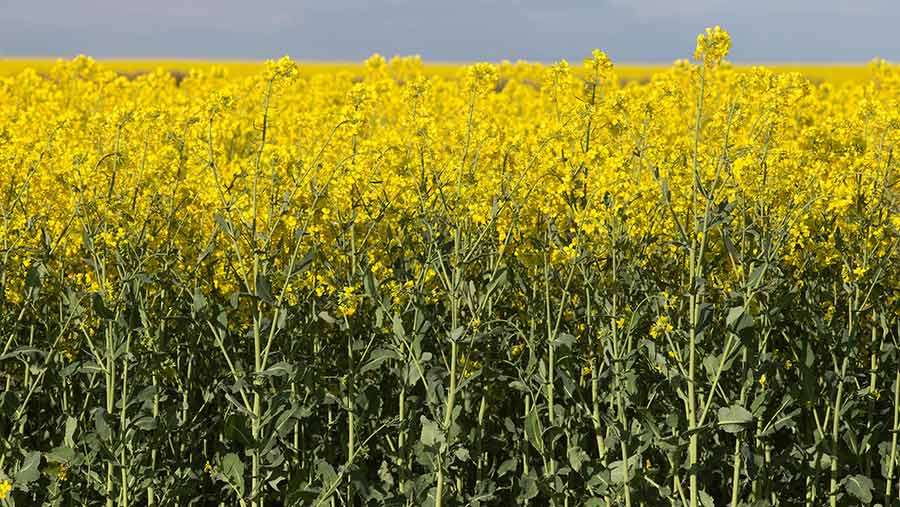Oilseed rape spot prices skyrocket to £800/t
 © Tim Scrivener
© Tim Scrivener Ex-farm oilseed rape spot prices collected by Farmers Weekly averaged £823.40/t on 23 March, up by £80.90/t on week-earlier levels.
This takes the commodity to nearly double where it was during the same week last year, driven by limited availability of old crop and high oil prices.
Grain traders have suggested high prices are likely to remain for some time while global supply stays tight.
See also: New advice from trials on combating flea beetle in OSR
The regional spread of prices was from £800/t in Shropshire to £833/t in Kent and East Sussex.
Frontier Agriculture commercial grain manager Philip Kimber said conflict has disrupted the flows of grains and sunflower oil from the Black Sea region.
Mr Kimber said: “Markets are looking to replace the reduced availability of vegetable oils due to this, and rapeseed oil is a possible substitute.”
While prices are exceptionally high for old crop, the forecast for new-season crop is reportedly a little more unpredictable and will be affected by how the situation in Ukraine evolves during the coming months, as well as other market drivers.
“We had a record Australian crop, which is flowing into Europe, and there is also a rebound in Canadian production as well,” said Mr Kimber.
Markets are currently pricing in a greater demand for old-crop supplies, according to CRM Agri’s oilseeds outlook, with a shortage of non-soya-based oilseed products through to harvest 2022.
The outlook suggests shortages of rapeseed, and the need to price at a premium will likely persist throughout next season.
Futures markets remain at exceptionally high levels despite recent decreases. Paris rapeseed futures (Matif) closed at €926.50/t (£771.59/t) for May 2022 on 23 March, down by €68/t (£56.11/t) on week-earlier levels.
Ukraine market impact
Peter Collier, senior adviser at CRM AgriCommodities, said Ukraine continues to be a large concern for the non-soya-based meal and oil supply, with sunflower markets taking centre stage.
“Not only have old-crop supplies of sunflowers from Ukraine been severely impacted, but spring planted, the area is a large unknown, while as war wages on, the harvest potentials for rapeseed in Ukraine is also an unknown.
“With supplies of sunflower meal and oil impacted, consumers will have been turning to rapeseed, which has also been limited in supply,” said Mr Collier.
“The global vegetable oil market has also continued to be supported by both crude oil and tight soya supplies. While longer term it remains possible that the vegetable oil market could well soften, the supply of meal next season will remain tight.”
Grain markets
UK feed wheat futures stood at £311/t for May 2022 at midday on Thursday (24 March), up by £12/t on week-earlier levels.
Ex-farm spot feed wheat averaged £300.60/t on 23 March, with a regional spread of £288/t in Gloucestershire to £322/t in Northumberland.
Feed barley prices averaged £287.60/t for ex-farm, with prices ranging from £282/t in Gloucestershire to £295/t in Norfolk and Suffolk.
Wheat prices continue to be driven by conflict in the Black Sea region, with countries that would traditionally import from Ukraine looking to secure grain from alternative regions, such as Europe.
Anthony Speight, senior analyst at AHDB, said: “With demand for EU-origin wheat forecast to increase, and if this conflict wages on, continental prices could well be supported, providing a further drive for domestic prices.
“With tight ending stocks for 2021-22, the old- and new-crop domestic market are now pricing even closer to import parity [prices same as the imported equivalent] with the continent.”
